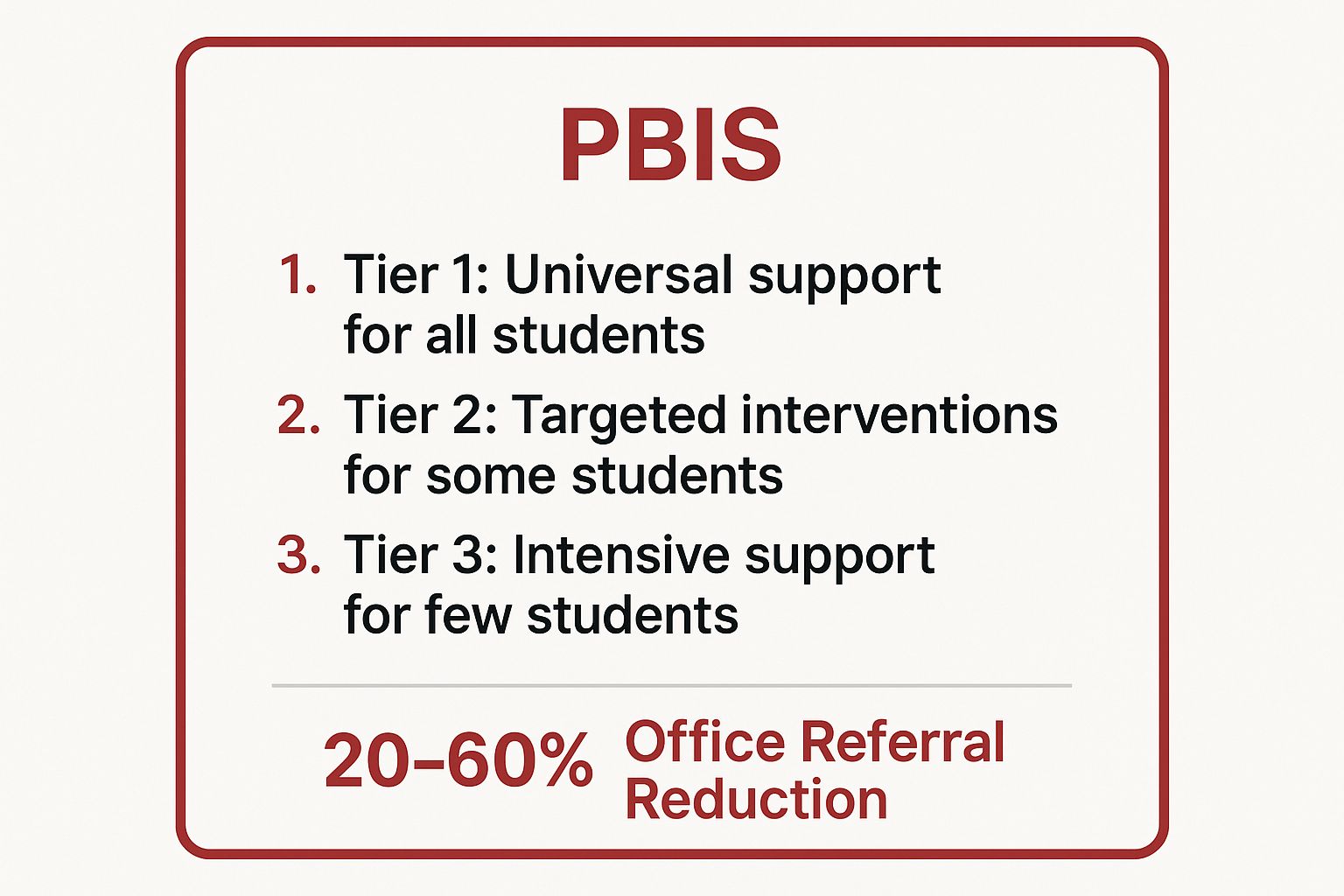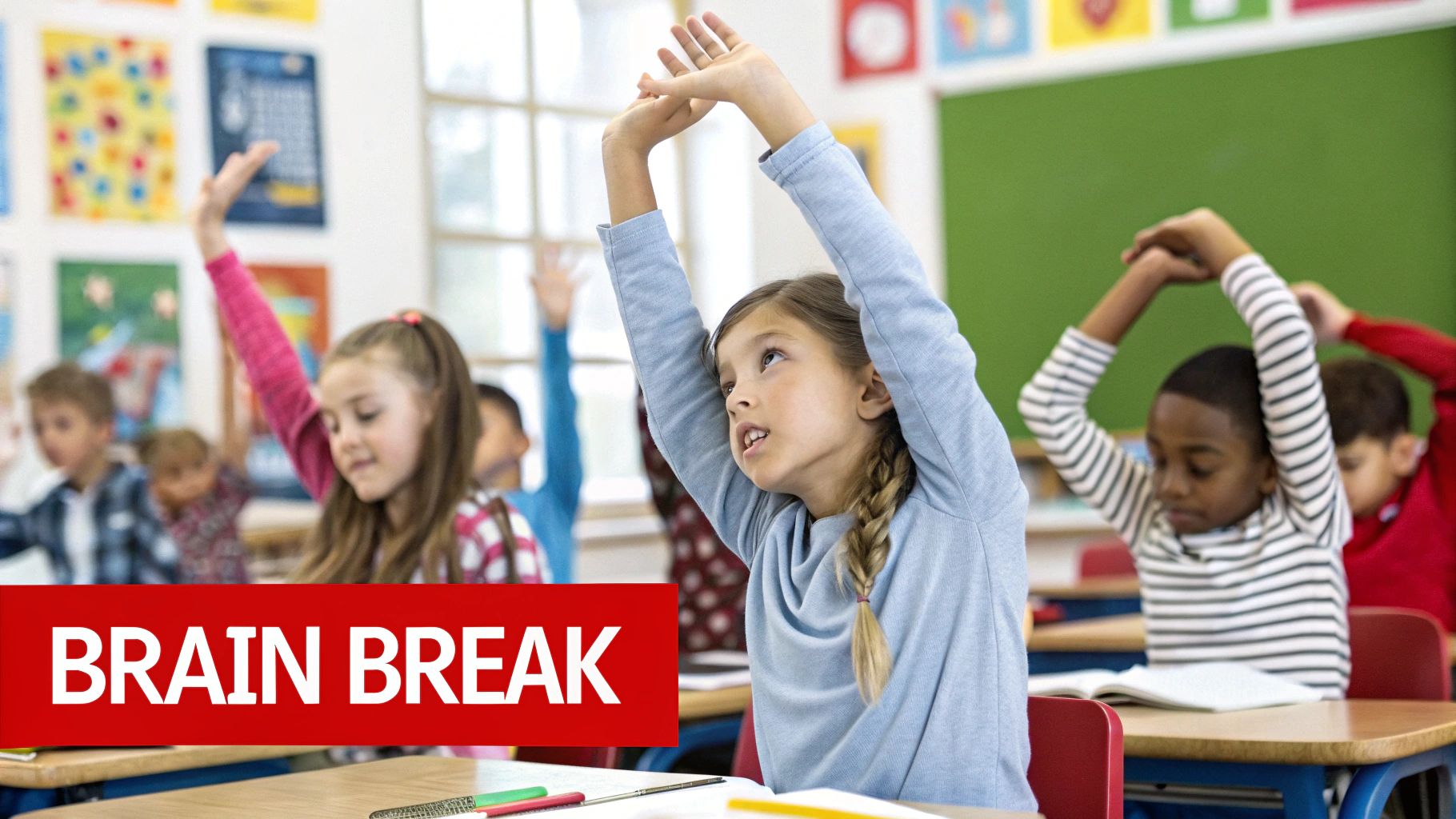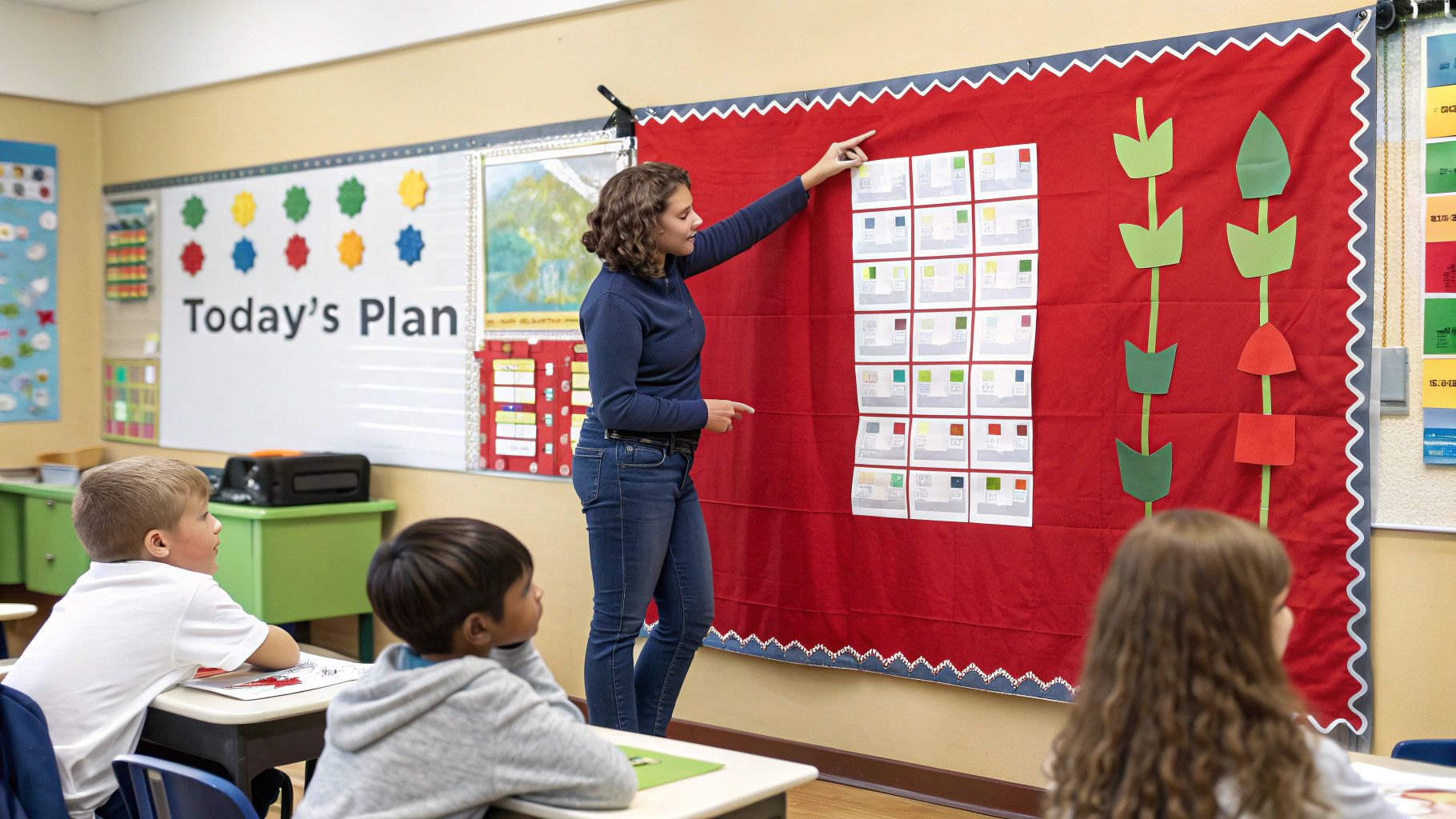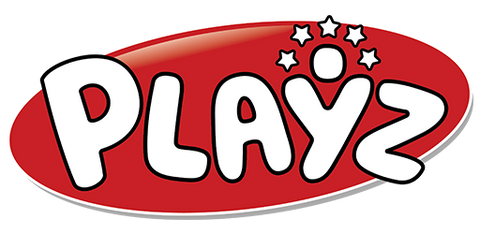
Top Classroom Management Strategies Elementary Teachers Love
Creating a positive, productive learning environment is the cornerstone of effective elementary education. Yet, managing a classroom full of diverse learners, boundless energy, and developing social skills can feel like a monumental task. The key isn't just reacting to disruptions, but proactively building a classroom culture where students feel safe, respected, and ready to learn.
This comprehensive guide moves beyond generic advice to provide a deep dive into powerful, research-backed classroom management strategies elementary teachers can implement immediately. Forget the constant battle for attention; it's time to build a self-regulating, engaged, and joyful learning community.
This article will explore practical, actionable frameworks designed for today's dynamic classrooms. You'll gain actionable insights on how to:
- Build a strong community with the Responsive Classroom approach.
- Empower students' self-regulation using The Zones of Regulation.
- Integrate movement and focus with structured Brain Breaks.
- Foster resilience through Growth Mindset and effort-based praise.
Each strategy is broken down with real-world examples and step-by-step tips to help you transform your classroom. This isn't about controlling behavior; it's about creating an environment where every student is equipped and motivated to succeed. Let's dive in.
1. Positive Behavior Interventions and Supports (PBIS)
Positive Behavior Interventions and Supports (PBIS) is a proactive framework designed to establish a positive school culture and prevent problem behaviors before they start. Instead of reacting to misbehavior, this approach focuses on explicitly teaching, modeling, and reinforcing desired behaviors. It’s one of the most effective classroom management strategies elementary teachers can adopt because it creates a supportive environment where all students can succeed socially, emotionally, and academically.
At its core, PBIS is about creating a shared understanding of expectations. Schools typically define 3-5 broad, positively stated behavioral expectations, such as "Be Respectful, Be Responsible, Be Safe." These are then explicitly taught and applied across all school settings, from the classroom to the playground.
Actionable Tip: How to Implement PBIS in Your Classroom
Implementing PBIS begins with clear, consistent teaching of your classroom expectations. A visual matrix showing what "Being Respectful" looks like during group work versus during hallway transitions can be incredibly effective for younger students. The key to success is frequent positive reinforcement.
- Acknowledge Positive Behavior: Aim for a 4:1 ratio of positive reinforcement to corrections. Use specific, brief praise like, "I saw you help Sarah pick up her crayons. That was a responsible choice."
- Use a Token Economy: Implement a school-wide system like "Gotcha Tickets" or classroom-specific tokens that students earn for meeting expectations. These can be exchanged for small rewards or privileges, like extra computer time.
- Model and Role-Play: Dedicate time during morning meetings to model and practice expected behaviors, especially before challenging transitions or activities. For example, role-play how to walk quietly in the hallway before heading to the library.
This tiered framework allows educators to provide the right level of support for every child. The following graphic summarizes the multi-tiered system that makes PBIS so effective.

As the data shows, a structured PBIS system not only supports individual students but also significantly reduces disruptive incidents school-wide, creating more time for instruction. By focusing on prevention and positive reinforcement, PBIS builds a foundation of respect and responsibility that benefits the entire classroom community. For more resources, visit the Center on PBIS.org.
2. Responsive Classroom Approach
The Responsive Classroom approach is an evidence-based method that integrates social-emotional learning with academic instruction. This strategy is founded on the principle that how children learn is as important as what they learn. Instead of focusing solely on behavior, it emphasizes building a strong, safe, and joyful classroom community where students feel a sense of belonging and significance. This positive environment naturally fosters better behavior, engagement, and academic achievement.
At its core, the Responsive Classroom approach is proactive and student-centered. It consists of a set of well-defined practices that help create a predictable and supportive learning atmosphere. These practices, such as Morning Meeting and shared rule creation, empower students and give them ownership over their classroom, making it one of the most effective classroom management strategies elementary educators can use.

Actionable Tip: How to Implement the Responsive Classroom Approach
Integrating this approach begins by establishing consistent routines that build community and teach social skills directly. The Morning Meeting is a cornerstone practice, providing a daily opportunity for students to greet one another, share, participate in a group activity, and start the day with a shared message.
- Create Rules Together: In the first weeks of school, facilitate a discussion where students help create 3-5 positively stated rules for the classroom, such as "Be respectful of people and property." This fosters buy-in and a shared sense of responsibility.
- Use Interactive Modeling: Instead of just telling students what to do, use a seven-step modeling process to show them procedures like how to transition to centers or use classroom materials. This clarity prevents confusion and misbehavior.
- Offer Academic Choice: Empower students by providing choices in their learning, such as selecting a topic for a writing assignment or choosing how to demonstrate their understanding of a concept (e.g., a poster, a skit, or a written report). This increases engagement and motivation.
By prioritizing positive relationships and teaching social-emotional competencies alongside academics, the Responsive Classroom approach helps create a cooperative and productive learning environment. It shifts the focus from managing behavior to nurturing a community of capable learners. For more detailed guidance, visit the Center for Responsive Schools.
3. Class Dojo and Digital Behavior Management Systems
Class Dojo and similar digital platforms are technology-based classroom management strategies elementary teachers can use to gamify behavior expectations and streamline parent communication. These tools provide real-time behavior tracking by allowing teachers to award points for positive actions and note behaviors needing improvement. This system transforms behavior management into an engaging, interactive experience for tech-savvy students.
The core of this strategy is immediate, visual feedback. Each student gets a digital avatar, and teachers can project the class roster onto a screen. When a student demonstrates a desired behavior, like "helping others" or "perseverance," the teacher awards a point with a satisfying sound effect, creating a positive and motivating classroom atmosphere.
Actionable Tip: How to Implement Digital Systems in Your Classroom
Effective implementation hinges on focusing the tool on positive reinforcement and clear communication rather than on punitive measures. The goal is to build positive momentum and keep parents looped into their child’s progress, creating a strong school-home connection.
- Emphasize the Positive: Maintain a high ratio of positive points to negative feedback, aiming for at least 5 positive for every 1 negative. To avoid public shaming, adjust settings so that only positive points are displayed publicly.
- Align with Class Rules: Customize the programmable behaviors in the app to directly match your established classroom rules (e.g., "Respectful Listening," "Responsible Cleanup"). This reinforces your core expectations.
- Use as a Communication Hub: Leverage the platform’s parent communication features to send class-wide announcements, share photos of student work, and send private messages. Teach parents how to use the app during back-to-school night.
- Create Meaningful Incentives: Allow students to redeem their earned points for non-tangible rewards and privileges, such as "lunch with the teacher," "extra free-reading time," or "choosing the class brain break."
By using data from the platform to identify patterns, you can provide targeted support to students who need it most. Digital systems like Class Dojo, when used thoughtfully, can make behavior management more efficient, transparent, and engaging for the entire classroom community. For more information, visit the ClassDojo.com website.
4. The Zones of Regulation
The Zones of Regulation is a powerful framework designed to foster self-regulation and emotional control. Created by Leah Kuypers, this approach teaches students to categorize their feelings and levels of alertness into four colored zones, providing a simple, shared language for discussing emotions. This strategy is highly effective in elementary classrooms because it empowers students to identify their feelings, understand how their behavior impacts others, and learn healthy coping strategies.
At its core, The Zones of Regulation helps students develop metacognitive awareness of their emotional states. The four zones are: the Blue Zone (sad, tired, sick), the Green Zone (calm, happy, focused, ready to learn), the Yellow Zone (frustrated, worried, silly, excited), and the Red Zone (angry, terrified, out of control). The goal isn't to stay in the Green Zone constantly but to recognize which zone you're in and use appropriate tools to manage it.
Actionable Tip: How to Implement The Zones of Regulation in Your Classroom
Implementing this framework starts with explicitly teaching the zones and the feelings associated with each. A visual chart in the classroom is essential. The key is to make zone identification a normal, non-judgmental part of the daily routine, helping students build emotional intelligence as a foundational skill.
- Create a "Zones Check-In": Start the day by having students identify their current zone. This can be done by moving a clothespin with their name to the corresponding color on a chart. This gives you a quick emotional snapshot of your class.
- Develop a Classroom "Toolbox": Work with students to create a "toolbox" of strategies for each zone. For the Yellow Zone, this might include fidget tools or taking a short break; for the Red Zone, it could be deep breathing exercises or getting a drink of water.
- Model and Use the Language: Consistently model your own feelings using the zones language. Saying, "I'm feeling a little in the Yellow Zone because the technology isn't working, so I am going to take a deep breath," normalizes the experience for students.
This systematic approach to emotional learning is a game-changer for classroom management. It moves beyond simply reacting to behavior and instead teaches the underlying skills students need to manage themselves successfully. By equipping children with the tools to navigate their feelings, you create a more empathetic and focused learning environment. For more information, you can visit the official Zones of Regulation website.
5. Nonviolent Communication and Conflict Resolution
Nonviolent Communication (NVC) is a powerful framework that shifts the classroom focus from punishment to connection. Instead of reacting to conflict with consequences, this approach teaches students to express their needs and feelings honestly while listening empathetically to others. Developed by Marshall Rosenberg, NVC is one of the most transformative classroom management strategies elementary teachers can use because it empowers children with the tools to solve their own problems peacefully.
The core of NVC is a four-step process that helps students communicate more effectively: observing without judgment, identifying feelings, recognizing underlying needs, and making clear, positive requests. By teaching this method, you create a classroom culture where conflicts become valuable opportunities for students to build essential social and emotional skills.
Actionable Tip: How to Implement NVC in Your Classroom
Implementing NVC starts with building a shared language for feelings and needs. Anchor charts, daily check-ins, and modeling are essential for making this approach a natural part of your classroom interactions. The goal is to make communication, not correction, the first response to conflict.
- Establish a "Peace Corner": Create a designated space where two students can go to resolve a conflict. Provide a script or visual aid with the NVC format: "I felt ___ when you ___ because I need ___. Would you be willing to ___?"
- Model NVC Language: Make your own thinking visible when managing the class. For example, "I feel frustrated when people talk during instructions because I need to be heard. Would you please wait until I finish?"
- Use Role-Playing: During morning meetings, use puppets or brief skits to act out common classroom conflicts like sharing supplies. Guide students through using the NVC steps to find a solution together.
This approach not only resolves immediate disputes but also builds a foundation for long-term emotional intelligence. By focusing on the needs behind behaviors, NVC helps create a more compassionate and collaborative classroom community. For more ideas on building these skills, explore these emotional intelligence activities for kids.
6. Brain Breaks and Movement Integration
Brain breaks are short, structured activities designed to give students a mental and physical reset from sustained cognitive effort. Research shows that elementary students have limited attention spans, making regular movement essential for focus and learning. This strategy involves integrating 1-5 minute movement activities, breathing exercises, or mindfulness moments throughout the day to increase blood flow to the brain, reset attention, and prevent the restlessness that can lead to off-task behavior. It is a powerful, proactive classroom management strategy elementary teachers can use to boost engagement and productivity.
The core principle behind brain breaks is that movement primes the brain for learning. By intentionally scheduling these brief interludes, teachers can help students stay focused, process information more effectively, and manage their energy levels in a positive way. Instead of waiting for students to become wiggly and distracted, this approach builds movement directly into the fabric of the school day.

Actionable Tip: How to Implement Brain Breaks in Your Classroom
Effective implementation of brain breaks requires proactive scheduling and a clear routine. The goal is to make these breaks a non-negotiable part of your classroom culture, not just an occasional reward. Start by scheduling them every 15-20 minutes for younger grades (K-2) and every 25-30 minutes for older elementary students (3-5).
- Vary Your Activities: Alternate between high-energy breaks like GoNoodle dances or academic jumping jacks (e.g., jump for each letter while spelling a word) and calming breaks like "balloon breaths" or chair yoga poses.
- Establish Clear Signals: Use a consistent sound or visual cue to signal the start and end of a brain break. This helps students transition quickly back to their academic tasks.
- Make It Academic: Connect movement to content. Try a "freeze dance" where students share a math fact when the music stops, or play "Simon Says" using academic vocabulary words. Incorporating hands-on learning activities is another great way to integrate movement.
This simple yet effective strategy helps manage the classroom's overall energy and prevents a significant amount of off-task behavior before it starts. The following video from GoNoodle provides a great example of a guided brain break you can use in your classroom.
By making brain breaks a consistent routine, you create a more dynamic and focused learning environment. This approach acknowledges the physical needs of young learners and uses movement as a tool to enhance, rather than disrupt, academic instruction.
7. Visual Schedules and Predictable Routines
Visual schedules and predictable routines provide a clear, picture-based or written roadmap of the day's activities, helping elementary students understand what to expect and when. This strategy creates predictability and reduces anxiety, especially for students who struggle with transitions or have special needs. It’s one of the most vital classroom management strategies elementary teachers can use because it makes the abstract concept of time concrete and visible, fostering independence and emotional regulation.
By establishing a predictable sequence of events, you create a secure learning environment where students can focus on learning rather than on what might happen next. This structure is foundational to a well-managed classroom, minimizing disruptions and empowering students to take ownership of their day.

Actionable Tip: How to Implement Visual Schedules in Your Classroom
Effective implementation goes beyond simply posting a schedule; it involves teaching and referencing it consistently. Start by explicitly teaching the routine through modeling and practice, especially at the beginning of the school year. Make the schedule a central, interactive part of your classroom.
- Make It Interactive and Visible: Use a pocket chart with activity cards that students can help update. Place it at their eye level. For individual needs, "First-Then" boards showing a task followed by a preferred activity can be highly motivating.
- Use Visual Timers: Pair your schedule with a visual timer (like a Time Timer) to show how much time is left for an activity. This helps students manage their time and prepare for the next transition.
- Prepare for Changes: While consistency is key, life happens. Teach flexibility by using a "change card" in your schedule to signal an unexpected event, giving students a heads-up and a chance to process the change.
A predictable environment supports all learners, particularly those who thrive on structure. These routines build a sense of safety that is essential for academic and social-emotional growth. This structured approach also complements other teaching methods, such as those discussed in guides to play-based learning benefits. By integrating visual supports, you empower students to navigate their day with confidence and success.
8. Growth Mindset and Effort-Based Praise
A growth mindset classroom is built on the belief that intelligence and abilities can be developed through dedication and hard work. Pioneered by Stanford psychologist Dr. Carol Dweck, this approach shifts the focus from praising innate talent to celebrating effort, strategies, and progress. This is a powerful classroom management strategy for elementary students because it cultivates resilience, reduces frustration-based disruptions, and encourages a love for learning.
The core of this strategy lies in changing the language we use. Instead of saying, "You're so smart," which promotes a fixed mindset, teachers use effort-based praise like, "I saw you use three different strategies to solve that math problem. Your persistence paid off!" This teaches students that challenges are opportunities to grow their brains, not tests of their inherent worth.
Actionable Tip: How to Implement Growth Mindset in Your Classroom
Implementing a growth mindset culture begins with explicitly teaching students how their brains work and consistently using language that reinforces effort. The goal is to make "I can't do this... yet" a common and accepted refrain in your classroom, turning moments of struggle into powerful learning experiences.
- Praise the Process, Not the Person: Focus your praise on specific, observable actions. Instead of "Good job," say, "You worked so hard to sound out those tricky words, and it made your reading much smoother."
- Teach Neuroplasticity: Use simple lessons, videos, or activities to show students that their brains are like muscles that get stronger with practice. This scientific basis makes the concept tangible for young learners.
- Model and Share Struggles: Talk openly about something you found difficult to learn and how you overcame it. This models that learning is a journey and that even adults face challenges.
- Celebrate Mistakes as Learning: Create an environment where errors are seen as valuable information. Use activities like "My Favorite Mistake" to analyze errors as a class and learn from them together.
By reframing how students view challenges and their own abilities, you build a classroom of motivated and persistent learners. This approach helps students develop problem-solving skills and see themselves as capable, which directly reduces behavior issues stemming from academic frustration. For more resources on this topic, learn how to develop problem-solving skills.
Classroom Management Strategies: 8-Point Comparison
| Strategy | Best For... | Key Advantage | Potential Challenge |
|---|---|---|---|
| Positive Behavior Interventions (PBIS) | School-wide behavior systems | Proactive and data-driven | Requires high level of school-wide commitment |
| Responsive Classroom Approach | Building a strong community | Integrates social-emotional learning | Requires daily time commitment for routines |
| Digital Behavior Management Systems | Tech-savvy classrooms; parent communication | Gamifies behavior and streamlines communication | Can be overused for negative tracking |
| The Zones of Regulation | Teaching emotional self-regulation | Provides a simple, common language | Needs consistent teaching and reinforcement |
| Nonviolent Communication | Conflict resolution and empathy | Empowers students to solve problems | Can be complex for very young students |
| Brain Breaks & Movement | Managing energy and improving focus | Quick, easy, and effective | Can be disruptive if not structured |
| Visual Schedules & Routines | Creating predictability and independence | Reduces anxiety and transition issues | Requires upfront preparation and maintenance |
| Growth Mindset & Effort Praise | Building resilience and motivation | Fosters a love of challenge and learning | Requires a conscious shift in teacher language |
Putting Your Plan into Play: Building a Better Classroom Today
Navigating the dynamic landscape of an elementary classroom requires more than a single trick up your sleeve. It demands a thoughtful, intentional approach built from a diverse toolkit of strategies. The most effective educators understand that true classroom management is not about control, but about connection, community, and empowerment. This means weaving together proactive systems that set clear expectations, teach crucial social-emotional skills, and honor the developmental needs of young learners.
The journey to a smoothly-run, positive classroom environment is a marathon, not a sprint. It involves blending the structured consistency of PBIS with the community-centric ethos of the Responsive Classroom approach. It means giving students the language to understand their feelings through frameworks like The Zones of Regulation while fostering peaceful problem-solving with Nonviolent Communication. These are not isolated tactics but interconnected pieces of a larger puzzle.
Key Takeaways for Your Classroom
The true power of these classroom management strategies for elementary students comes from their synergy. A teacher might use a visual schedule to provide predictability, incorporate brain breaks to support regulation, and then use growth mindset language to praise the effort students show when re-engaging with a difficult task. The goal is to move beyond simply reacting to misbehavior and instead build a resilient classroom culture where students feel safe, seen, and capable.
Here are the core principles to carry forward:
- Be Proactive, Not Reactive: Structure your classroom with clear routines, visual aids, and predictable schedules. When expectations are clear, students are set up for success from the moment they walk in the door.
- Teach the Skills You Want to See: Don't assume students know how to manage big emotions or resolve conflicts. Explicitly teach these skills using tools like The Zones of Regulation and conflict resolution scripts.
- Focus on Connection: At the heart of every effective strategy is a strong student-teacher relationship. Building trust and mutual respect is the foundation upon which all other management techniques stand.
Ultimately, your role is that of an architect, designing a learning environment where every child can thrive. This isn't about finding a magic bullet but about becoming a responsive, reflective practitioner who observes students' needs and adapts accordingly. By consistently applying these classroom management strategies for elementary settings, you cultivate an atmosphere where academic engagement flourishes, and students develop the self-regulation skills they will carry with them for a lifetime.
Ready to energize your well-managed classroom with hands-on learning that captivates and educates? Explore the exciting world of Playz science kits and discover how active, engaging play can reinforce positive behavior and spark a lifelong love for discovery. Transform your classroom into a hub of curiosity and make learning an unforgettable adventure.
